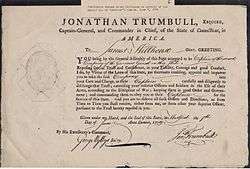James Hillhouse
| James Hillhouse | |
|---|---|
 | |
| United States Senator from Connecticut | |
|
In office December 6, 1796 – June 10, 1810 | |
| Preceded by | Oliver Ellsworth |
| Succeeded by | Samuel W. Dana |
| Member of the U.S. House of Representatives from Connecticut's At-Large district | |
|
In office March 4, 1791 – December 5, 1796 | |
| Preceded by | Benjamin Huntington |
| Succeeded by | James Davenport |
| Member of the Connecticut House of Representatives | |
|
In office 1780–1785 | |
| Personal details | |
| Born |
October 20, 1754 Montville, Connecticut |
| Died |
December 29, 1832 (aged 78) New Haven, Connecticut |
| Resting place | Grove Street Cemetery, New Haven, Connecticut |
| Political party | Federalist |
| Alma mater | Yale University |
| Profession |
lawyer realtor politician |
James Hillhouse (October 20, 1754 – December 29, 1832) was an American lawyer, real estate developer, and politician from New Haven, Connecticut. He represented Connecticut in both the U.S. House and Senate.
Biography
Hillhouse was born in Montville, Connecticut, the son of William Hillhouse and Sarah (Griswold) Hillhouse.[1] At the age of seven, he was adopted by his childless uncle and aunt, James Abraham and Mary Lucas Hillhouse. He attended the Hopkins Grammar School in New Haven, Connecticut and graduated from Yale College in 1773. At Yale he was a member of the Linonian Society. He studied law and was admitted to the bar in 1775 and practiced law in New Haven.

During the Revolutionary War, Hillhouse served as captain of the Second Company of the Governor's Foot Guard. During the successful British invasion of New Haven on July 5, 1779, he commanded troops alongside Aaron Burr with Yale student volunteers.[2]
Career
Hillhouse was a member of the Connecticut House of Representatives from 1780 to 1785. He was a member of the Connecticut council of Assistants from 1789 to 1790; and was elected as a United States Congressman from Connecticut at-large for the Second, Third, and Fourth Congresses and served from March 4, 1791, until his resignation in the fall of 1796.[2]
Elected as a United States Senator on May 12, 1796, to fill the vacancy caused by the resignation of Oliver Ellsworth, Hillhouse was reelected in 1797, 1803, and 1809, and served from December 1796, until June 10, 1810, when he resigned. During the Sixth Congress he was President pro tempore of the Senate.[3]
In 1803, Hillhouse and several other New England politicians proposed secession of New England from the union due to growing influence of Jeffersonian democrats and the Louisiana Purchase which they felt would further diminish Northern influence. Hillhouse was elected a member of the American Antiquarian Society in 1813.[4] In 1814-10 he was a Connecticut delegate to the Hartford Convention, and treasurer of Yale College from 1782 to 1832.[5]
Death
Hillhouse made major contributions to the beautification of New Haven.[5] He was active in the drive to plant the elm trees that gave New Haven the nickname of the Elm City. Hillhouse Avenue and James Hillhouse High School in New Haven are named for him. He died in New Haven on December 29, 1832 (age 78 years, 69 days) and is interred at the Grove Street Cemetery, New Haven, Connecticut.[6] He was a nephew of Matthew Griswold, and uncle of Thomas Hillhouse.
References
- ↑ "James Hillhouse". The Political Graveyard. Retrieved 29 December 2012.
- 1 2 "James Hillhouse". Biographical Directory of the United States Congress. Retrieved 29 December 2012.
- ↑ "James Hillhouse". Govtrack US Congress. Retrieved 29 December 2012.
- ↑ American Antiquarian Society Members Directory
- 1 2 "James Hillhouse" (PDF). Harriet Beecher Stowe Center. Retrieved 29 December 2012.
- ↑ "James Hillhouse". Find A Grave. Retrieved 29 December 2012.
External links
- United States Congress. "James Hillhouse (id: H000618)". Biographical Directory of the United States Congress.
- James Hillhouse High School website
| United States House of Representatives | ||
|---|---|---|
| Preceded by Benjamin Huntington |
U.S. Representative from Connecticut (at large) March 4, 1791 – December 5, 1796 |
Succeeded by James Davenport |
| United States Senate | ||
| Preceded by Oliver Ellsworth |
U.S. Senator (Class 1) from Connecticut 1796–1810 Served alongside: Jonathan Trumbull, Jr., Uriah Tracy, Chauncey Goodrich |
Succeeded by Samuel W. Dana |
| Political offices | ||
| Preceded by John E. Howard |
President pro tempore of the United States Senate February 28, 1801 – March 4, 1801 |
Succeeded by Abraham Baldwin |

